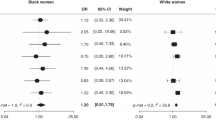Abstract
Objective: An increased risk of ovarian cancer among users of antidepressants and benzodiazepines has been observed in some but not all prior studies. We examined these associations in a population-based case–control study. Methods: We identified 314 members of a health maintenance organization (HMO) who were diagnosed with epithelial ovarian cancer between 1981 and 1997, were aged 35–79 years at diagnosis, and had at least 4 years of HMO membership. Up to four controls were selected for each case (n = 790), matched on age, calendar year, and length of HMO membership. Information concerning past medication use was obtained from the computerized pharmacy database, established in 1977. Results: Cases were slightly less likely than controls to have filled two antidepressant prescriptions (primarily for doxepin, amitriptyline, or imipramine) in any 6-month period prior to a reference date set 1.5 years before diagnosis (conditional odds ratio (OR) 0.71, 95% confidence interval (CI) 0.47–1.1), or to have used an antidepressant continuously for 6 months or longer (OR 0.64, 95% CI 0.36–1.1). Cases were less likely than controls to have filled two benzodiazepine prescriptions in 6 months (OR 0.70, 95% CI 0.47–1.0) or to have used benzodiazepines continuously for 6 months or longer (OR 0.53, 95% CI 0.15- 1.9). Conclusions: Our findings suggest that there is not an increased risk of ovarian cancer in women who have taken some types of antidepressants or benzodiazepines.
Similar content being viewed by others
References
Harlow BL, Cramer DW (1995) Self-reported use of antidepressants or benzodiazepine tranquilizers and risk of epithelial ovarian cancer: evidence from two combined case-control studies (Massachusetts, United States). Cancer Causes Control 6: 130-134.
Harlow BL, Cramer DW, Baron JA, Titus-Ernstoff L, Greenberg ER (1998) Psychotropic medication use and risk of epithelial ovarian cancer. Cancer Epidemiol Biomarkers Prev 7: 697-702.
Coogan PF, Rosenberg L, Palmer JR, et al. (2000) Risk of ovarian cancer according to use of antidepressants, phenothiazines, and benzodiazepines (United States). Cancer Causes Control 11: 839-845.
Brandes LJ, Arron RJ, Bogdanovic RP, et al. (1992) Stimulation of malignant growth in rodents by antidepressant drugs at clinically relevant doses. Cancer Res 52: 3796-3800.
Iishi H, Tatsuta M, Baba M, Taniguchi H (1993) Enhancement by the tricyclic antidepressant, desipramine, of experimental carcinogenesis in rat colon induced by azoxymethane. Carcinogenesis 14: 1837-1840.
Lin X, Levitsky DA, King JM, Campbell TC (1999) The promotion effect of anorectic drugs on aflatoxin B-1-induced hepatic preneoplastic foci. Carcinogenesis 20: 1793-1799.
LaBella FS, Brandes LJ (1996) Enhancement of tumor growth by drugs with some common molecular actions. Mol Carcinogen 16: 68-76.
Wright SC, Zhong J, Larrick JW (1994) Inhibition of apoptosis as a mechanism of tumor promotion. FASEB J 8: 654-660.
Kitagawa YF, Katahira M, Matsuda K, et al. (1985) Evaluation of the induction of hepatic drug-metabolizing enzymes in the rat and mouse treated with temazepam using trimethadione as the indicator. J Toxicol Sci 10: 21-28.
Ballinger B, O'Malley K, Stevenson IH, Turnbull MJ (1971) Stimulation of drug metabolism by centrally active drugs. Br J Pharmacol 41: 383P.
Fukazawa H, Iwase H, Ichishita H, Takizawa T, Shimizu H (1975) Effects of chronic administration of bromazepam on its blood level profile and on the hepatic microsomal drug-metabolizing enzymes in the rat. Drug Metab Disp 3: 235-244.
Psaty BM, Heckbert SR, Atkins D, et al. (1994) The risk of myocardial infarction associated with the combined use of estrogens and progestins in postmenopausal women. Arch Intern Med 154: 1333-1339.
Saunders KW, Stergachis A, Von Korff M (1994) Group Health Cooperative of Puget Sound. In: Strom BL, ed. Pharmacoepidemiology. Chichester: John Wiley, p. 181.
Harris BL, Stergachis A, Ried LD (1990) The effect of drug copayments on utilization and cost of pharmaceuticals in a health maintenance organization. Med Care 28: 907-917.
Author information
Authors and Affiliations
Rights and permissions
About this article
Cite this article
Dublin, S., Rossing, M.A., Heckbert, S.R. et al. Risk of epithelial ovarian cancer in relation to use of antidepressants, benzodiazepines, and other centrally acting medications. Cancer Causes Control 13, 35–45 (2002). https://doi.org/10.1023/A:1013969611593
Issue Date:
DOI: https://doi.org/10.1023/A:1013969611593




